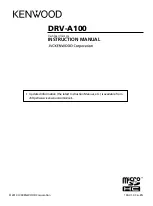
8
• Do not handle the power cord if your hands are wet. Handling it with wet hands may lead
to electrical shock. When unplugging the cord, ensure that you hold the rigid portion of
the plug. Pulling the cord may damage or expose the wire and short-circuit, fires or
electrical shocks.
• Use of power sources not expressly recommended for this equipment may lead to
overheating, distortion of the equipment, fire, electrical shock or other hazards. Use only
the recommended power accessories.
• Use of batteries not expressly recommended for this equipment may cause explosions or
leaks, resulting in fire, injury and damage to the surroundings. Use only recommended
batteries and accessories.
• Use only Ni-MH Charger NC-E2 to charge the NP-E3. Use of chargers not expressly
recommended may result in overheating, distortion, fire or electrical shock.
• Do not place the batteries near heat or in water. Such exposure may damage the
batteries and lead to the leakage of corrosive liquids, fire, electrical shock, explosion or
serious injury.
• Do not attempt to disassemble, alter, or apply heat to the batteries. There is serious risk
of injury due to an explosion. Immediately flush with water any area of the body, including
the eyes and mouth, or clothing, that comes into contact with the inner contents of a
battery. If the eyes or mouth contact these substances, immediately flush with water and
seek medical assistance.
• Avoid dropping or subjecting the batteries to severe impacts that could damage the
casings. This could lead to leakage and injury.
• Do not short-circuit the battery terminals with metal, such as key holders. This could lead
to overheating, burns and other injuries. Use the supplied protective cover to transport or
store the battery.
• Before you discard a battery, cover the terminals with tape or other insulators to prevent
direct contact with other objects. Contact with the metallic components of other materials
in waste containers may lead to fire or explosions. Discard batteries in specialized waste
facilities if available in your area.
• Disconnect Ni-MH Charger NC-E2 from electrical outlet after recharging and when the
camera is not in use to avoid fires and other hazards.
• The camera terminal of the DC Coupler Kit DCK-E1 is designed for exclusive use with the
EOS-1Ds. Do not use it with other products or batteries. There is a risk of fire and other
hazards.
IMPORTANT
• Do not remove the CF card from the camera while the CF card access lamp is blinking. A
blinking access lamp indicates that data on the CF card is being written or read. Remov-
ing the card at such a time will destroy the data.
• When connecting the camera to a personal computer, do not use any interface cable
other than the one provided with the camera. Using the wrong cable may result in
malfunction.
Summary of Contents for EOS-1
Page 80: ...80 ...
Page 152: ...152 ...









































